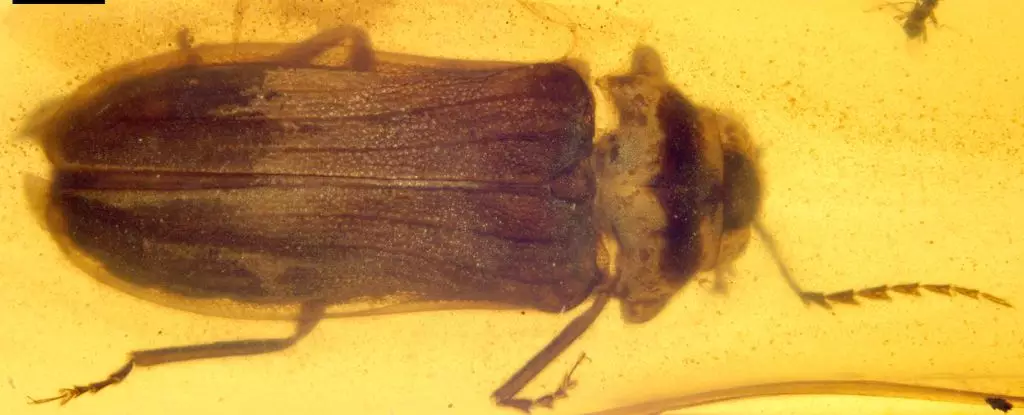The soft luminescence of fireflies on a summer evening evokes a sense of wonder, inviting us to marvel at the small but significant intricacies of nature. These enchanting creatures, known scientifically as Lampyridae, boast an impressive array of approximately 2,500 identified species globally, showcasing a distinct bioluminescent capability that captures our imagination. While their magical dance of light serves multiple functions, the evolutionary trajectory that led to such a remarkable trait has long fascinated researchers. Recent studies led by paleontologist Chenyang Cai unveil new insights hidden within the confines of amber, suggesting that the origin of firefly bioluminescence dates back much further than previously thought.
The recent discovery of a perfectly preserved firefly specimen, Flammarionella hehaikuni, entombed in 99 million-year-old amber from Myanmar, stands as a testament to the evolutionary timeline of fireflies. This beetle, akin to an echo from the Mesozoic era, reveals that bioluminescence was not merely a developing trait but rather a well-established feature among its ancestors. Cai’s team’s significant finding, alongside previous discoveries like Protoluciola albertalleni, suggests that by the time of its existence, firefly lanterns had already diversified, shedding light on the complex evolutionary mechanisms at play.
The uniqueness of Flammarionella lies in its anatomical structures. Unlike its contemporaries, the lantern structure comprises two segments at the end of the abdomen, underscoring diversity not only in the function of bioluminescence but also in the morphological characteristics that evolve alongside it. This finding sparks crucial questions about the environmental and social factors that may have influenced these developments in ancient ecosystems.
The captivating glow of fireflies serves critical functions in their lifecycle, primarily revolving around mating and survival. Bioluminescence acts as a beacon for attracting potential mates, where males and females engage in visual signaling that increases their chances of reproduction. However, findings suggest that fireflies may also utilize their luminous abilities as a defense mechanism against predation. The lucibufagins they harbor—chemical compounds toxic to many predators—serve as a fitting warning sign as they illuminate their surroundings. Interestingly, the recent discourse among scientists points toward the notion that bioluminescence appeared before lucibufagins, hinting at alternative early advantages of this glowing trait.
Understanding the evolutionary advantages of bioluminescence could elucidate broader ecological dynamics at play in ancient environments. It raises pivotal discussions about competition for mates and avoidance of predation, as well as the nuances of communication within these insect populations.
A closer look at Flammarionella hehaikuni reveals particularly intriguing features beyond its light-emitting capabilities. The male and female fireflies within this group exhibit marked differences, especially in their antennal structures. The female specimen identified boasts densely packed hair-like appendages known as setae, which have been linked to enhancements in olfactory sensitivity. This peculiar design hints at an evolutionary adaptation that plays a significant role in mate selection and pheromone recognition, foundational elements in firefly sexuality.
As the search for more fossilized specimens continues, discovering male fireflies from the same era could illuminate the evolutionary pressures that sculpted these fascinating appendages and deepen our understanding of their role in the mating rituals of these bioluminescent beetles.
The ongoing exploration of ancient amber deposits holds promise for unlocking further secrets of firefly evolution. While Cai and his team have made strides in exploring the intricate relationships between form and function in bioluminescent insects, much remains unknown. Future excavations and analyses of Mesozoic insects may provide invaluable context for the evolutionary significance of light in insect behavior, ecology, and interactions with other organismal communities.
In essence, the story of fireflies transcends their ephemeral beauty; it speaks to the broader narrative of life’s resilience and adaptation through the ages. As researchers unravel the layers of time locked within amber, we inch closer to understanding the complex interplay of evolution—a process that continues to shape the natural world in unexpected ways. The enchanting glow of fireflies, once a mere summer pastime, becomes a beacon of inquiry into the deep-rooted mysteries of our planet’s biological history.

Leave a Reply